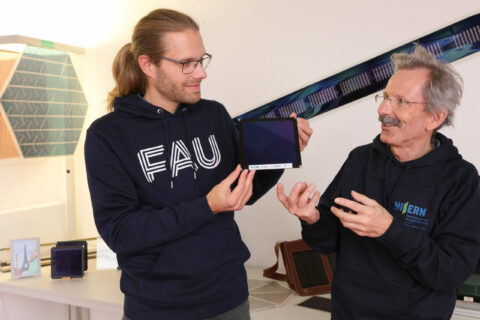World record in solar energy

The most efficient organic solar module in the world comes from FAU and HI ERN
The sun is one of the most important sources for renewable energy, solar energy is a central component of the energy transition. The most efficient solar module in the world at the current time has been developed by a researcher at Friedrich-Alexander-Universität Erlangen-Nürnberg (FAU) in close collaboration with the Helmholtz Institute Erlangen-Nürnberg for Renewable Energy (HI ERN), that belongs to Forschungszentrum Jülich: Dr. Andreas Distler at the Chair of Materials Science (Materials in Electronics and Energy Technology). It reaches a new certified* record rate of efficiency of 14.46 percent, breaking the previous world record for organic photovoltaic modules (OPV) of 13.1 percent from Waystech. This proves that organic photovoltaic technology can rival silicon and the like in the future.
Bavaria’s Minister of Energy Hubert Aiwanger congratulated the researchers. “Organic PV modules offer new options for using photovoltaic technology. The increase in efficiency will allow us to exploit the potential of solar energy even better than before. Pioneering innovations such as these are just what Bavaria needs.”
Finding the perfect material
The photovoltaics market is hungry for innovation. After all, solar energy is one of the greatest hopes for the energy transition. This is also reflected in the scope of research conducted in this pioneering field. One of the greatest challenges: finding the perfect material.
When it comes to efficiency, the material silicon seems almost untouchable. However, it has serious disadvantages: too rigid, too heavy, difficult to recycle. Researchers led by Dr. Christoph Brabec, Professor of Materials in Electronics and Energy Technology at FAU and director of the Helmholtz Institute Erlangen-Nürnberg for Renewable Energy (HI ERN) therefore pursue a different approach: they hope to conquer the market with organic photovoltaics (OPV). The advantage of OPV: The modules can be flexible and transparent, they can be integrated into windows and facades, used indoors or as roofing in fields, for example as a grow tunnel. They also have the advantage of having a much better ecological footprint – the manufacturing processes are more environmentally friendly, the material is easier to recycle.
“Solution-processed organic photovoltaics will become an important component of a photovoltaics strategy that focuses on rapidly expanding capacity and options for integration. Similarly to perovskites, this opens the door to solar applications going beyond solar power plants in desert regions. Organic photovoltaics can therefore make a sustainable contribution towards bringing the production of solar technologies back to Europe,” explains materials scientist Christoph Brabec.
The technology’s weakness currently lies in its efficiency: While silicon modules have an efficiency factor of over 20 percent, researchers struggled to achieve efficiency reaching double figures with OPV just a few years ago. It is all the more welcome when new records are set in this area, one step at a time. The team led by Christoph Brabec has managed to raise the degree of efficiency to 14.46 percent.
Dr. Andreas Distler, who scored the coup, worked on three parameters: “First, we used improved active materials. However, we also focused on reducing the inactive areas on the module. We continued work on optimizing the laser structuring process that splits the module surface into individual solar cells and wires them up to each other. Here the trick is to keep the laser lines as thin as possible, as this area on the module cannot produce electricity later,” explains the FAU researcher. “Finally we succeeded in developing a homogeneous coating together with colleagues from the Technische Hochschule Nürnberg Georg Simon Ohm using computer simulations. All of these are small efficiency boosters, that add up together to increase efficiency by one percent point.”
“For the successful cooperation between FAU and HI ERN, part of the Forschungszentrum Jülich, this new world record is a particularly visible milestone. It once more underlines the significance and success of the pioneering Solar Factory of the Future operated jointly by both institutions at Energie Campus Nürnberg,” adds Christoph Brabec. “Thanks to the financial support of the Bavarian Ministry of Economic Affairs, the Solar Factory of the Future provides a unique process infrastructure which we can use to transfer our technical developments and breakthroughs extremely efficiently and rapidly via the innovation platform Solar TAP. We are achieving similarly impressive results by developing printed perovskite solar cells as with entirely printed tandem cells.”
*Fraunhofer ISE (CalLab PV Cells) in Freiburg
Contact:
Dr. Andreas Distler
Chair of Materials Science (Materials in Electronics and Energy Technology)
Phone: + 49 911 5302 99357
andreas.distler@fau.de